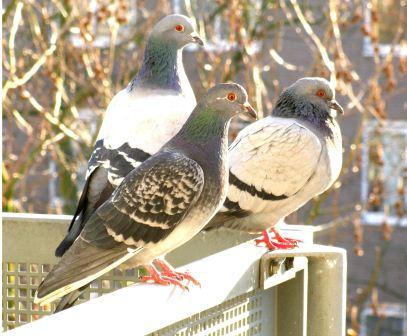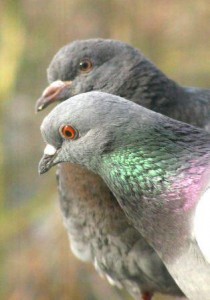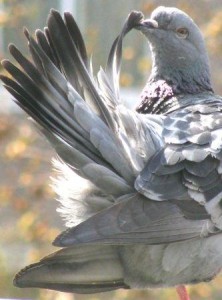Pigeons Aren’t Pests!
They’re beautiful birds, and killing them doesn’t work

By Marleen Drijgers. (Photos by Regina Jockwer)
In 1995 I moved from Rotterdam to Vlissingen in the southwest of Holland. My new neighbor, an old lady who reminded me of my grandmother, used to feed pigeons on her rooftop. I loved to watch her and the pigeons having a good meal.

So I went up onto my own rooftop and put a small tub and a big bowl of water there, and after their breakfast, the pigeons used to drink and bathe in it. It was lovely to see their joy splashing in the water. Also I liked watching the pigeons helping each other fixing up their feathers and loving each other. Once a week, I had to clean my rooftop from pigeon dung, but I didn’t mind that for the pleasure exceeded the nuisance.
One day, my lovely old neighbor died. A week after her death, 50 cages were put on her rooftop to catch and kill all the pigeons she used to feed. I was deeply shocked seeing the contract killer doing his job. From that moment, I did my utmost to prevent the pigeons from being caught in the cages. I informed the local newspaper and local radio, and with a friend I collected signatures from citizens and shopkeepers in order to save the pigeons. I got no support from animal protection organizations, who considered pigeons to be of low status and gave no priority rescuing them. But I did succeed in convincing the town council to stop the killing.
The publicity from this resulted in requests from people in other cities who wanted to save their pigeons, too. And that’s how it all started.
In 1999, I got cancer and had to stop working. During my recovery I decided to devote my time to helping animals. I started creating lofts for pigeons, where they can safely eat, sleep and brood, and similar shelters for feral cats. I also joined a new political party, The Party for the Animals, which won two seats in the Dutch parliament.
 It was good being able to help a few pigeons, but there were so many more who needed help. In Holland, as in most other countries, pigeons are seen as simply vermin. Pest control companies and professional exterminators, who are in the business of killing them, spread disinformation saying that the birds spread diseases and should therefore be killed. Pigeons are even called “flying rats” to stigmatize them even more so more people will pay to have them killed.
It was good being able to help a few pigeons, but there were so many more who needed help. In Holland, as in most other countries, pigeons are seen as simply vermin. Pest control companies and professional exterminators, who are in the business of killing them, spread disinformation saying that the birds spread diseases and should therefore be killed. Pigeons are even called “flying rats” to stigmatize them even more so more people will pay to have them killed.
So, now we have more and more people believing that pigeons are a risk for their health. But across the world, there have only been 176 cases documented over a period of 62 years of illness being transmitted from wild pigeons to humans.
In any case, it’s been shown very clearly that killing pigeons does not reduce their numbers. The more pigeons are caught, trapped, shot and poisoned, the more will simply be born. It’s nature’s way.
In Manchester, England, for example, 2,800 pigeons were living in the city center. The city council decided to reduce the population by half. So, for three years, they kept catching pigeons and killing them until there were just 1,400 left. How many pigeons did they have to catch and kill to reduce the population from 2,800 to 1,400. The arithmetic would say that 2800 – 1400 = 1400 pigeons. But no, it took the city three years, and they had to catch 9,000 pigeons to get to their goal of having just 1,400!
Now, I’ll be first to admit that a flock of pigeons can be considered a nuisance on certain buildings. But there’s an easy, humane way to relate to this. We just have to create pigeon lofts, where the pigeons can make their homes.
 In my next post, I’ll explain how people in cities all over the world can make simple pigeon lofts that are kind to the birds, as well as being far less expensive than paying extermination companies to kill them by the thousands and millions.
In my next post, I’ll explain how people in cities all over the world can make simple pigeon lofts that are kind to the birds, as well as being far less expensive than paying extermination companies to kill them by the thousands and millions.
~~~~~~~~~~~~~~~~~~~~~~~~~~~~
Marleen Drijgers is the founder of the European Working Group for Effective Pigeon Control
